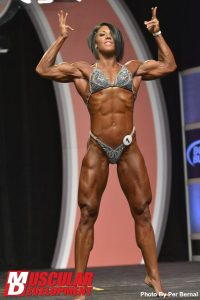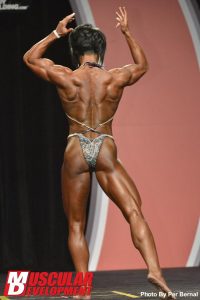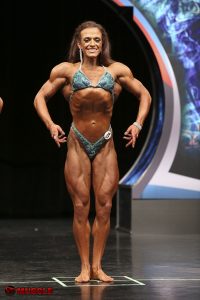
Since debuting in 2011, the women’s physique division has been steadily gaining in popularity, filling the void left by the not-so-willful departure of women’s bodybuilding from the competitive landscape as the latter was quietly swept under the rug by the powers that be, largely due to it’s lack of commercial appeal and excessive drug use required to be competitive.
After a bit of a “settling in” period, the judging standards in this division have somewhat settled into place, only to be potentially disrupted by a joint NPC/IFBB annoucenment on August 1st, 2018 that can easily be interpreted as one of their classic “downsizing” attempts (which have traditionally failed to accomplish their goal).
What we learn from history
The historical pattern goes like this: competitors get bigger and leaner to a degree only possible with additional chemical assistance, and lines between divisions get blurred. The organization issues a statement saying excessive size and conditioning will be marked down and attempt to get each division “back in their lane”. Judges most often ignore those guidelines and continue to just judge the physiques that are on stage (can’t blame ’em there).
Eventually, the NPC/IFBB creates a new division that will supposedly target the aesthetic they really want, and every night show gets an hour longer and everyone in the audience and backstage gets more impatient (my apologies, I’m a bit cynical…can you tell?)
Women’s Physique made it’s debut on the Big Stage ™ of Olympia Weekend in 2013, as a “showdown” – much like the 212 men’s division and men’s physique in the same time frame, the “showdown” basically meaning they were going to hand out awards but the cash prizes were going to be a pittance.
Just starting Out in Women’s Physique?
Women’s Physique is a division where the degree of difficulty ramps up significantly as the size of the show increases. More so than in other divisions, winning your class or overall in a local show does not in any way necessarily mean you’re ready to be competitive on a national stage. It takes longer to develop your physique for this division than for others – yes there’s a similar amount of fine tuning and refinement needed, but in physique you also just need more raw size than in figure or certainly bikini.
Classes in a lot of local shows are small – at the Knox Classic in my hometown recently, they brought all 3 WPD classes (A, B, and C) on stage at once. A and C had one competitor each, while B had 4 (sandwiched in the middle). This was a chance for those in their own class to at least run through quarter turns and mandatory poses with other people on stage and get a more “official” experience under their belt, which was nice.
Point being – winning a class of 1 and earning your Nationally Qualified status doesn’t mean you’re ready to use it (in this case, at least one of them certainly was but that’s not the norm!). As always, have plenty of eyes on your physique, or at least one good set of eyes that’s NOT your own to keep you grounded in reality (this can work both ways, as you may only see your flaws when realistically yes, you are ready for a bigger stage).
Women’s Physique – evolution through the years
As we’ve done before, let’s stroll down memory lane and check out the winner of the first Women’s Physique Olympia Showdown in 2013.
Oh yeah, remember her? Dana Linn Bailey quickly become the icon of the sport before retiring in 2015. By almost any measure, she looks great. How does she compare to current champs?
This is Alyssa Coppolina who won the Vancouver Pro show in July of this year. What changes are evident? It’s pretty clear: harder. Thicker. Denser. More muscular fullness. More separation. More conditioned. You’ll also find more aggressive posing stances to be the norm now.
A quick note – go check out the WPD gallery from the 2013 Olympia Showdown and let’s take a second to marvel at how unbelievably crazy those results were. You can knock any of those competitors for any number of things – DLB for her blocky-looking quads (no one with quads like that is ever winning a pro show ever again), and just go on down the list…you’ve got some nondescript physiques with nothing particularly noteworthy, some fair(ish) conditioning on some – until you get to Juliana Malacarne.
SOMEHOW she came in 7th when I think it’s pretty clear she should have won the whole thing (as she did the following year). Her shapes, size, fullness, and symmetry are on a different planet from everyone else, and her conditioning was fine – in fact, it’s pretty much exactly what the judging guidelines say they’re looking for – separation, no striations, etc. I have no idea who she had pissed off that year but there had to be something going on.
Judging standards – a moving target?
At any rate, it’s easy to see why the NPC/IFBB announcement on judging standards (read it here) was made – things are moving in a direction that is unsustainable, unhealthy, and competitors are starting to speak up about it. Check out the following discussion between Rosie Hart and Jamie Pinder as Jamie talks about the cost and sacrifice of coming in as conditioned as she routinely does for shows (hint: it ain’t pretty). Note: sound balance in this interview is awful but if you’re interested it’s worth putting up with.
That interview went up the same day as the announcement from the IFBB/WPD which seems like quite a coincidence, but I also don’t think those organizations react quickly enough for it to be a direct response.
Is Women’s Physique Right For You?
How do you know if Women’s Physique is the right division for you? The first thing I always tell aspiring competitors – look at a lineup of the various divisions at a show, and identify the one that you most want to see yourself in. That is your division. It’s that simple. Which one appeals the most. Is it the best fit for your body? Honestly, I think that’s a secondary consideration at best.
You’re the one that has to live with your body every day of the year, getting judged on stage might be 10 minutes out of your life – aim for the physique that YOU want. Think you’re undersized for WPD? Well, work harder and smarter, and be patient. If you feel like competing earlier than might be optimal, either do so in WPD knowing you might be smaller than you like, or hit a show in Figure to whet your appetite and see how that feels, as kind of a “pit stop” on the way to your true target.
Women’s physique is fun – because except in the most extreme cases, they don’t punish size – so if you want to pack it on and have the ability to do so, do it. Competitors are barefoot, so if you hate the heels then this is your calling. The posing is much more intricate as well, as you’re hitting the same quarter turns as in figure but with additional mandatories on top of that (front/back double bicep, side chest, side chest, abdominal/thigh). At a bodybuilding show, it’s kinda fun to get up on stage and flex and not be limited to just quarter turns. Also, you can put together a free-form routine of your own set to music to perform at finals. Lots of freedom of expression allowed here, which makes it unusual compared to the other women’s divisions.
Long Term Considerations for Women’s Physique Competitors
So if WPD is your thing, what does that mean for you? Let’s talk about some long-term strategy points for getting the most out of your body.
- Phase things correctly and pick your shows carefully. With women’s physique especially, prep is hard due to the level of conditioning you need to achieve and (for some/many) the chemical assistance needed to bring your absolute best. Picking shows willy-nilly is a bad move. Ensure that your calendar is pretty free so your prep can go as smoothly as possible with a minimum of planned interruptions. Cluster your shows together if doing more than one – maybe 2-3 weeks apart, rather than 2-3 months apart as it becomes too difficult to maintain or improve upon your conditioning over a longer period like that when you’re already going to be stretched thin and DYING for your prep to be over. This division places high demands on every part of you, if you do it well.
- Enjoy an off-season – because of the above, it’s important to have an off-season or period between shows when you can relax, eat a bit, do less cardio, come off any and all supplementation, and just let your body b r e a t h e. This does NOT mean you can’t still push hard on training and in fact you SHOULD to continue improving – but pick your spots to chill out a bit and enjoy living like a sane person for a bit. It’s good in the long run.
- Choose your path – natural or assisted? If it’s the latter, make sure you have a clear understanding of what you’re getting in to. Ask your coach, yes, but also READ UP ON YOUR OWN and verify what he or she is telling you as best you can. Chemical assistance in WPD is very common, but it’s not a path to walk down carelessly or without a good, solid long-term plan as well as intelligent short-term cycle management. General rule of thumb: if your coach writes up a first cycle for you that has more than one compound, question it HARD.
Women’s Physique Training Priorities
Due to the nature of the division and the presentation involved, everything needs to be prioritized. Unlike Figure, where you can give chest and arms less attention periodically and get away it – in physique, those muscle groups are showcased in their own distinct poses and if you neglect them, it’ll show (this is assuming a fairly balanced baseline physique. If you already have arms that overpower the rest of you, take this with a grain of salt). Still, we want to make sure that we’re thinking about the following:
- Quads: we want that sweep but we need to really work that separation as well. Focusing on a mixture of slower tempos, heavier weights, and varied foot positioning with your quad work will help. Posing practice can also develop your mind/muscle connection to make it easier to flex your way to improved separation also.
- Glutes and hamstrings – larger, fuller glutes are in these days. You don’t need a load of banded work (as is fashionable these days) but a good mixture of compound and simple hip extension moves worked in as part of a multi-leg day split is a smart move.
- Arms – good idea to give them their own time, or at least pair with another single upper body group (rather than trying to work in 3 groups in one session, such as chest/shoulders/triceps…ugh) unless you’re following a very high intensity protocol that benefits from lower volume and/or higher frequency.
- Chest/shoulders – a bit of a conundrum for those with implants, as a high volume of direct chest work isn’t the best idea in all cases but yes, pec development still counts. Not an easy answer there! Putting these 2 groups together on one day isn’t a terrible idea so long as the shoulders can still get thoroughly worked.
- Back – we need V-Taper, thickness and density in the back in equal measure. If your back development is off, that back double bicep pose will show it and leave no question about it. Don’t be afraid to hit back twice weekly if it isn’t a strength – work it until it is! If you can hit the back poses and have your upper body pop with some real density and get that separation in your hamstrings, you’re going to be a force to be reckoned with.
Bring it all home
Are you interested in competing in women’s physique, or have you competed before and maybe you’re looking to step up your game? Check out the details on my online coaching program for contest prep. All programs are customized for you and I offer a high level of feedback engagement with everyone I work with.
Looking for a good workout routine based on the criteria I spelled out above? Head on over and check out my workout plans – the Women’s Physique Blueprint was designed from the ground up to target the aesthetics that are rewarded in this division. Several other programs there are also a good fit for aspiring WPD competitors. In particular, #1, 2, 3, 5, and 7 are all completely appropriate!
Or maybe you just have more questions after reading all this – that’s ok too! Reach out and let me know how I can help and I’ll be happy to set the record straight however I can and answer whatever questions you have. If you’d like to get an opinion on your overall readiness or prospects for competing in Women’s Physique, we can conduct an evaluation via email as well!




